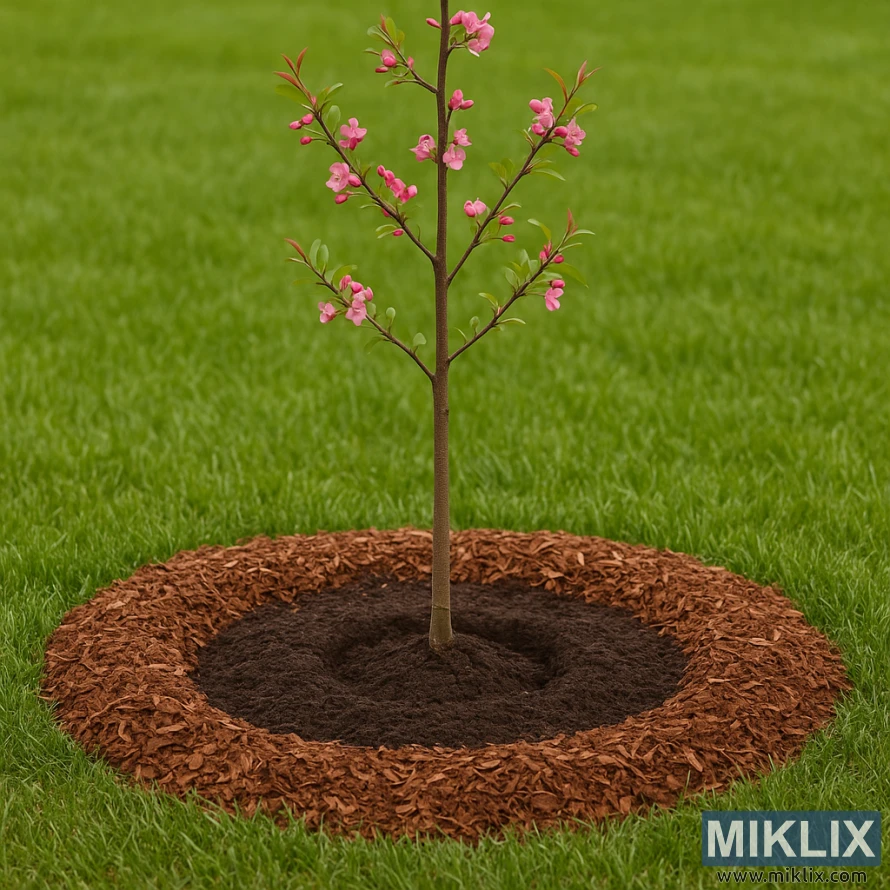Image: Proper Planting and Mulching for a Young Crabapple Tree
Published: November 21, 2025 at 11:34:09 PM UTC
Illustration of correct planting depth and mulching technique for a young crabapple tree, showing a well-prepared circular mulch ring and healthy soil structure essential for tree establishment.
The image depicts a young crabapple tree planted with exemplary horticultural care, serving as a visual guide for the proper planting technique essential to ensure healthy establishment and long-term growth. The scene is set outdoors during the daytime, bathed in soft, even natural light that highlights the fine details of the planting site and the tree’s structure. The slender, upright trunk of the crabapple is centered in a perfectly round planting bed surrounded by a lush, evenly trimmed green lawn. The tree itself displays a small but balanced canopy of delicate branches, each carrying clusters of fresh, light pink blossoms interspersed with small, glossy, deep-green leaves that catch the light. The blossoms, typical of crabapple varieties, have five petals each and appear slightly translucent under the sunlight, emphasizing the tree’s youthful vigor and ornamental value.
At the base, the tree’s root flare is clearly visible at the soil surface, demonstrating correct planting depth—neither too deep nor too shallow—allowing roots to breathe and preventing trunk rot. The soil immediately surrounding the trunk is slightly recessed to form a shallow basin that aids in watering efficiency, ensuring moisture reaches the root zone without accumulating against the bark. Around this basin, a wide ring of dark, organic mulch is carefully laid in a circular shape, approximately two to three inches deep, with a clear gap around the trunk to avoid contact with the bark. The mulch appears to consist of medium-textured, reddish-brown wood chips that provide both aesthetic contrast and practical benefits: conserving soil moisture, regulating temperature, and suppressing weed growth.
The transition between the mulch ring and the surrounding lawn is crisp and well-defined, showcasing excellent landscape maintenance and emphasizing the importance of creating a distinct planting zone for young trees. The soil under the mulch is dark and rich, indicative of good drainage and fertility, which are critical for the healthy development of a young crabapple’s root system. The overall landscape is simple yet instructional—there are no competing plants or decorative elements to distract from the focus on correct planting and mulching technique. The background features only the uniformly textured green turf, which frames the planting area and directs the viewer’s attention to the tree and its immediate environment.
This image effectively communicates the core principles of proper crabapple planting: correct depth placement, visible root flare, well-aerated soil, and a properly applied mulch layer with adequate spacing from the trunk. It encapsulates the horticultural best practices recommended by arborists and extension services for establishing young ornamental trees, particularly those prized for their seasonal blooms like crabapples. The overall impression is one of balance, precision, and care—a model example of how thoughtful planting and maintenance contribute to the successful growth of one of the best crabapple tree varieties.
The image is related to: The Best Crabapple Tree Varieties to Plant in Your Garden

